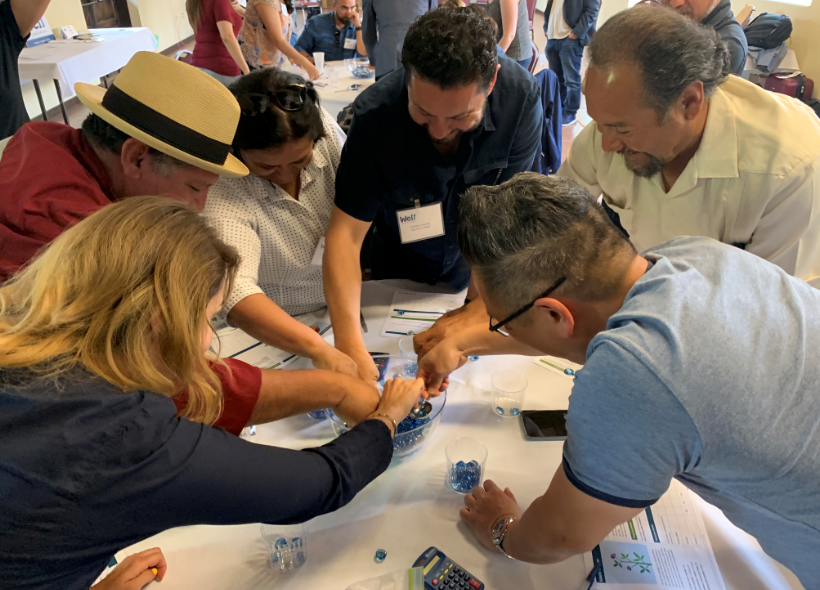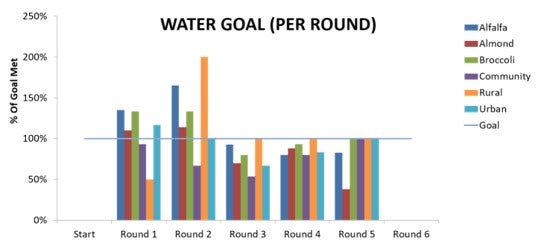One evening, at a community center in the Sacramento Valley, a teacher, a civil engineer, a tomato farmer and a local foundation board member found themselves standing above a table, feverishly competing to scoop the most glass beads from a large, communal bowl.
But there was a catch.
Each of them had a different sized spoon to scoop the blue beads based on their assigned role and corresponding levels of access to groundwater in the Groundwater Game.
The game simulates the challenges and tradeoffs that water agencies will inevitably face when developing and implementing plans to balance groundwater supply and demand as required by California’s Sustainable Groundwater Management Act, or SGMA. EDF co-developed the game with two University of Michigan professors, Robert Goodspeed and Colleen Seifert, and Environmental Incentives.

Local elected officials and farmers compete to scoop the most groundwater beads from their shared aquifer while playing the Groundwater Game in the Central Valley.
The interactive simulation educates players about groundwater management challenges and strategies such as water trading. It is also a fun, informative way to engage diverse members of the community in developing groundwater management plans, a key SGMA requirement.
Under SGMA, regions with the most critically over-drafted groundwater must submit their management plans by January 2020 — less than six months from now. With this deadline looming, a new toolkit provides instructions, role cards and information about where to buy game materials to make playing the Groundwater Game easier and more accessible.
Feedback from game participants
We’ve played the Groundwater Game with dozens of elected officials, community members and university students in California in recent months.
Allison Martin, an educator in Solano County, played the Groundwater Game in the Sacramento Delta. Afterward she told us:
Before playing the game I had only superficially considered the interconnectedness of groundwater use and availability, and had never really thought about how different users can work together to manage the aquifer and ensure everyone’s needs are adequately met. I feel more mindful of this now. The Groundwater Game helps stakeholders realize that their role in groundwater management should always be a cooperative one.
Now we’re collaborating with Allison to create a version of the game for high school students.
The game can be adapted relatively easily to meet the needs of different partners. Most recently, we worked with Self Help Enterprises to adapt the game and train facilitators for a groundwater management workshop in the Central Valley with a group of about 50 stakeholders.
How the game works
The Groundwater Game typically takes 60 to 75 minutes to play and requires one facilitator with a laptop for each group of six players.
Each player is assigned one of six roles: alfalfa grower, almond grower, broccoli grower, community water system, rural family or urban water utility.
The game involves five to six rounds of play with each round representing one year. During the first two rounds, players can pump as much as possible from the communal aquifer, simulating an “open access” scenario.
Pumping is simulated by scooping beads for 15 seconds from a clear bowl and putting them into a small cup that represents a player’s holding tank. Players count how many beads they have “pumped,” or scooped, and the facilitator enters the results into a spreadsheet to calculate farmers’ profits and produce graphs that show the effects of the pumping on the aquifer and whether each player’s water needs have been met.
The almond grower and urban water utility players “pump” with a tablespoon because they typically require more water. The rural family player “pumps” with the ¼ teaspoon because a rural family requires less water. The broccoli grower, alfalfa grower and community water system “pump” with a teaspoon because their needs fall in between the others.
Tense negotiations
In later rounds, players are allocated water based on historic “pumping” — how much they scooped in previous rounds — and can trade water.
In the final round, players must collectively decide how to distribute their groundwater. This is when the game gets more interesting — and unpredictable — because reaching consensus can require difficult negotiations.
The game shows players that it isn’t easy to manage competing interests while balancing groundwater supply and demand. But doing so will be necessary to comply with SGMA and ultimately ensure that California is more resilient to drought and finite groundwater supplies in the face of climate change.
We have grant funds to engage stakeholders by playing the Groundwater Game through 2020. If you are interested in playing the game, please contact Ronna Kelly at rkelly@edf.org.












One Comment
So much useful information, thank you!